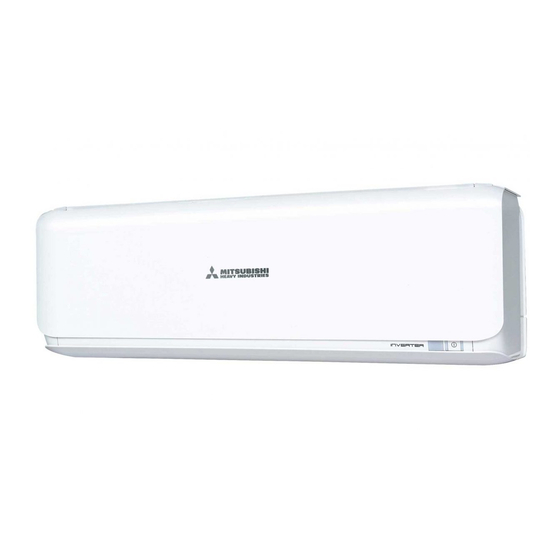Summarization of Contents
2. Exterior Dimensions
Indoor Unit Dimensions
Dimensions for indoor units SRK20, 25, 35, 50 series.
Outdoor Unit Dimensions
Dimensions for outdoor units SRC20, 25, 35, 50 series.
Remote Control Dimensions
Dimensions of the wireless remote control unit.
3. Electrical Wiring
Indoor Unit Wiring Diagram
Schematic showing electrical connections for indoor units.
Outdoor Unit Wiring Diagram
Schematic showing electrical connections for outdoor units.
4. Noise Level
Sound Power Level
Sound power level measurements for indoor and outdoor units across frequencies.
Sound Pressure Level
Sound pressure level measurements for indoor and outdoor units at various frequencies.
Sound Pressure Level by Fan Speed
Sound pressure levels for indoor units across different fan speeds.
5. Piping System
Refrigerant Piping Diagrams
Illustrates refrigerant flow and component connections for different model series.
6. Range of Usage and Limitations
Performance Selection Charts
Charts showing capacity correction factors based on temperature and piping length.
8. Application Data
Indoor Unit Installation
Guidelines and safety precautions for installing the indoor unit.
Outdoor Unit Installation
Guidelines and safety precautions for installing the outdoor unit.
9. Operation Control by Microcomputer
Wireless Remote Control Functions
Details the functions and buttons of the wireless remote control.
Unit ON/OFF Button Operation
Explains how to use the unit's physical ON/OFF button for basic operation.
Auto Restart Function
Describes the auto restart feature and settings that are cancelled.
Two Air-Conditioners in Same Room Setup
Details how to set up units for single remote control operation.
Annual Cooling Function Selection
Explains how to enable/disable annual cooling control and its effects.
Heating Only Function
Describes how to enable heating-only mode by disconnecting a jumper wire.
High Power Operation Mode
Details the high power operation mode for enhanced cooling/heating.
Economy Operation Mode
Explains the economy mode for energy saving and its operational adjustments.
Air Flow Direction Adjustment
How to adjust flap and louver directions using the remote control.
3D Auto Operation
Describes automatic control of fan speed and airflow direction for efficient conditioning.
Timer Operation Modes
Details comfort start-up, sleep timer, OFF timer, and weekly timer operations.
Silent Operation Mode
Explains how silent operation reduces fan and compressor speeds.
Night Setback Operation
Describes the heating operation adjustment for night setback.
Air Flow Range Setting
How to set the left/right air flow range based on installation location.
Display Brightness Adjustment
How to adjust the brightness of the unit display.
16. Outline of Heating Operation
Heating Mode Component Operation
Explains component operation during heating, including thermostat and fan control.
Heating Mode Control Details
Details control patterns for fuzzy operation, hot keep, and defrost operations.
17. Outline of Cooling Operation
Cooling Mode Component Operation
Explains component operation during cooling, including thermostat, fan, and compressor.
Cooling Mode Control Details
Details control patterns for fuzzy operation during cooling mode.
18. Outline of Dehumidifying (DRY) Operation
Purpose of DRY Mode
Explains the purpose of DRY mode is dehumidification, not humidity control.
DRY Mode Control Outline
Describes control of fan speed and compressor based on temperature difference.
19. Outline of Automatic Operation
Automatic Operation Mode Determination
Explains how operation mode is determined by indoor and outdoor air temperatures.
Mode Changes in Automatic Operation
Describes mode changes based on temperature conditions and thermostat settings.
20. Protective Control Function
Dew Prevention Control (Cooling)
Prevents dewing on the indoor unit by controlling fan speed and humidity.
Frost Prevention Control (Cooling/Dehumidifying)
Prevents frost formation on the outdoor heat exchanger during cooling/dehumidifying.
Cooling Overload Protection
Protects against excessive operating current in cooling mode by adjusting compressor speed.
Cooling High Pressure Control
Prevents anomalous high pressure operation during cooling by controlling compressor speed.
Cooling Low Outdoor Air Temperature Protection
Controls compressor speed based on low outdoor air temperature during cooling.
Heating High Pressure Control
Prevents anomalous high pressure operation during heating by controlling compressor speed.
Heating Overload Protection
Protects against excessive operating current in heating mode by adjusting compressor speed.
Heating Low Outdoor Temperature Protection
Controls compressor speed based on low outdoor air temperature during heating.
Compressor Overheat Protection
Prevents compressor damage from overheating by monitoring discharge pipe temperature.
Current Safe Control
Controls current to prevent exceeding operation limits, reducing compressor speed.
Current Cut Protection
Protects the inverter by stopping the compressor if output current exceeds the set value.
Outdoor Unit Failure Detection
Detects outdoor unit failures and stops the compressor if a critical issue is found.
Indoor Fan Motor Protection
Protects the indoor fan motor by stopping the unit if it operates at low speed for too long.
Serial Signal Transmission Error Protection
Prevents malfunctions caused by communication errors between indoor and outdoor units.
Rotor Lock Detection
Detects compressor rotor lock and stops the compressor to prevent damage.
Outdoor Fan Motor Protection
Protects the outdoor fan motor by stopping the compressor and fan if it operates at low speed.
Outdoor Fan Control at Low Temperature
Controls outdoor fan speed based on low ambient temperatures for cooling and heating.
Refrigeration Cycle System Protection
Protects the refrigeration cycle by stopping the compressor under specific temperature and speed conditions.
10. Maintenance Data
General Cautions for Maintenance
Important safety precautions to follow before performing maintenance or disassembly.
Troubleshooting Pre-checks
Checklist of preliminary items to verify before starting troubleshooting.
Troubleshooting: Unit Not Running
Step-by-step guide to diagnose and resolve issues when the unit fails to start.
Troubleshooting: Unit Runs but Malfunctions
Guide to diagnose and resolve issues when the unit runs but malfunctions.


















Need help?
Do you have a question about the SRK20ZS-W and is the answer not in the manual?
Questions and answers